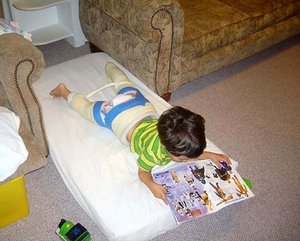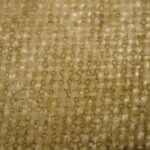If your child is 2 to 3 years old and in a hip spica cast, be prepared for a lot of extra work.
Our 3-year-old son Akira broke his left femur this summer and was in a fiberglass hip spica cast — that encircled his waist and both legs — for seven and a half weeks. (See “Akira Broke His Leg.”) I personally took care of him and hired a babysitter to look after his triplet brothers. This was a burdensome expense, but there was no way to avoid it. Here are some care-giving tips based on our experience:
1. Watch the child at all times. Someone should be assigned to care for him, and him only, the entire time he’s in the cast. There are several reasons for this:
a) He may stick toys, utensils or other objects down the cast. He might do this to scratch an itch – hip spica casts can get hot, and your child will sweat – or just for fun. If things get lodged in the cast, this could cause extreme irritation, break the skin and ultimately result in an infection. The only way to remedy this is to remove the cast, which means a new one will have to be put on.
Besides being a huge hassle for you and your family, this could also be putting your child at risk. As patients, 2 and 3 year olds tend not to be cooperative and are usually put to sleep for the application of a hip spica cast. Whenever general anesthesia is administered there is always the possibility — however remote — that the patient could die.
b) He might accidentally re-injure himself. After Akira had healed for a few weeks and built up some upper-body strength, he kept trying to drag himself across the floor. We once caught him trying to pull himself up the stairs. Another time Akira attempted to stand up. In both cases he could have suffered a fall, damaged the cast and hurt himself.
c) He may drop food or pour liquid into the hip spica cast. Because you can’t clean the interior of the cast, this could necessitate the removal and reapplication of the cast. Your child may also eat something that gives him diarrhea, which may run down into the cast. (See “Keeping the Hip Spica Cast Clean.”)
d) His diaper needs to be checked often. If he is not toilet trained, as my son wasn’t, he’ll have to wear a diaper. If the diaper gets full and leaks it will overflow and soak into the lining of the hip spica cast. We checked Akira’s diaper every hour. I once went two hours without checking him and his diaper leaked. His cast smelled like a public urinal for days afterward.
You should also check frequently to make sure the diaper is on properly. We found the best way for Akira to wear a diaper was to shove the ends up under the cast, instead of fastening it around the outside. The drawback with this method is that the diaper can slip out if your child moves around too much. (The disadvantage of fastening it on the outside of the cast is that the cast is then more likely to get soiled.)
2. Keep the child cool. Because it encircles the waist and both legs, hip spica casts can get very hot. It was summer when Akira had his cast put on, so we had the air conditioner set at 76F (24.5C) and running day and night in his room (the living room).
3. Keep the child downstairs, if possible. Akira’s bedroom is upstairs, but the nurse advised us to set up a bed for him downstairs, as we might drop him carrying him up and down the steps. This also avoids a situation where, being upstairs, he may try to drag himself downstairs, and hurt himself doing so.
4. Bathe your child every day. This is necessary because children sweat a lot wearing a hip spica cast. To keep his cast dry during the bath, we laid Akira on a plastic sheet placed on a bed and wiped him down with a damp washcloth. To wash his hair — which we also did every day — we had him lie on his back and hang his head over the side of the bed (the plastic sheet hung over the side too, under him). We then shampooed and rinsed his hair, using as little water as possible, over a plastic storage container — which you can find at any Wal-Mart or Target. This was a long and involved bathing process at first, but once I got the hang of it I was able to do it in under 20 minutes.
5. If your child needs a pain reliever — Akira did the first few days — give him Children’s Tylenol, not Children’s Advil. Akira’s post-op nurse told us that Advil may interfere with the healing process, so Tylenol is the preferred pain reliever. She did not offer an opinion on any other brand of pills.
6. Have your child lie on a mattress during the day. Patients in a hip spica cast cannot sit up; they must lie flat. A mattress will keep the cast and your floor from getting damaged. Akira played with his toys, watched TV and interacted with his triplet brothers from a child-size mattress we put on the living room floor.
7. Take him out at least once a day. Special reclining wheelchairs are available for patients in hip spica casts. If one isn’t available, lay him in a wagon padded with pillows. Both you and your child will appreciate the time outside of the home.
8. Get a special car seat, one specifically designed for hip-spica-cast patients.
9. Don’t panic if your child becomes mobile. Akira began pulling himself across the floor as soon as he had developed enough upper-body strength to do so. The orthopedic surgeon told us he didn’t want Akira moving around, but unless you tie him down, there’s no way to prevent him. We let him scoot around the room and spin in place (an activity he loved to do to music), but drew the line at climbing the stairs and attempting to stand up. We also let him play with a fabric tunnel with his brothers.
10. Watch that your child doesn’t hurt others with his cast. Once he has healed enough and gotten used to wearing his hip spica cast, your child will start treating it like another appendage. Akira flipped his up, down and around like a mermaid with a concrete tail. We had to watch that he didn’t accidentally hit his brothers or bring it down on one of our feet. Our neighbor, who volunteered to babysit one afternoon, told us Akira knocked his cast against her leg and gave her a bruise.
11. Your child may act fearful once the cast is removed. Akira cried and cried. He had grown accustomed to this heavy weight about his waist; when it was suddenly removed he was disoriented and afraid. Putting a pillow on his legs made him feel better. As your orthopedic surgeon will tell you, do not bend his legs or force him to sit up right away. When you leave the doctor’s office, place your child in the reclining wheelchair as if he still had the cast on. Akira couldn’t sit up or bend his legs until the next day.
To read more about our experience and Akira’s recovery, see:
“Akira Broke His Leg”
“Keeping the Hip Spica Cast Clean”
For further information on hip spica casts, see:
Hip Spica Cast: Everything You Need to Know
Hip Spica Cast Patient Information (Vanderbilt Children’s Hospital)
Hip Spica Cast: A Guide for Patients (Univ. of Iowa Children’s Hospital)





